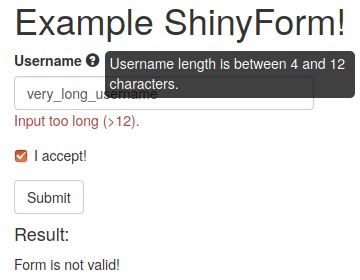ShinyReForms – Getting Started
Motivation
ShinyReforms was designed to make HTML form validation in Shiny easier. It offers an object-oriented interface to create standalone forms with Shiny-native building blocks and allows for easy embedding in your existing Shiny app.
Example
In this example we will build a simple form which is going to look like this:

ShinyForm
We first create a ShinyForm object:
myForm <- shinyreforms::ShinyForm$new( "myForm", submit = "Submit", onSuccess = function(self, input, output) { yourName <- self$getValue(input, "name_input") output$result <- shiny::renderText({ paste0("Your name is ", yourName, "!") }) }, onError = function(self, input, output) { output$result <- shiny::renderText({ "Form is invalid!" }) }, shinyreforms::validatedInput( shiny::textInput("name_input", label = "Username"), helpText="Username length is between 4 and 12 characters.", validators = c( shinyreforms::ValidatorMinLength(4), shinyreforms::ValidatorMaxLength(12), shinyreforms::Validator$new( test = function(value) value != "test", failMessage = "Username can't be 'test'!" ) ) ), shinyreforms::validatedInput( shiny::checkboxInput("checkbox", label = "I accept!"), validators = c( shinyreforms::ValidatorRequired() ) ) )
Let’s break this snippset down. A ShinyForm is an R6 class which is used to define the form. First argument to the constructor is form id by which you can refer to the form later on. The second argument is the submission button label.
The two callbacks onSuccess and onError are called when the form is submitted and respectively passes or fails the validation. The self argument refers to the form itself, while the input and output are the usual Shiny objects.
The remaining ellipsis (...) arguments are shiny tags from which the form will be composed. The shiny tags are enclosed in the shinyreforms::validatedInput function which adds validators to the input tag, as well as an optional tooltip (helpText).
Validators
Validators are functions which return TRUE or FALSE when passed an input value. ShinyReForms defines a number of pre-defined validators (such as ValidatorMinLength) and allows users to create custom validators.
For example in
# snip
shinyreforms::validatedInput(
shiny::textInput("name_input", label = "Username"),
helpText="Username length is between 4 and 12 characters.",
validators = c(
shinyreforms::ValidatorMinLength(4),
shinyreforms::ValidatorMaxLength(12),
shinyreforms::Validator$new(
test = function(value) value != "test",
failMessage = "Username can't be 'test'!"
)
)
),
# snipwe have created a Shiny textInput which will pass validation only if the length of the input is between 4 and 12 and the username is not test.
UI
To include your form in your UI it is enough to call its ui method. For example:
ui <- shiny::bootstrapPage( shinyreforms::shinyReformsPage( # This adds a dependency on shinyreforms .css shiny::fluidPage( shiny::tags$h1("Example ShinyForm!"), myForm$ui(), # <- ShinyForm will be included here! shiny::tags$h4("Result:"), shiny::textOutput("result") ) ) )
Conclusion
This is it – now you can run your App with
shiny::shinyApp(ui = ui, server = server)
and examine the resulting form!